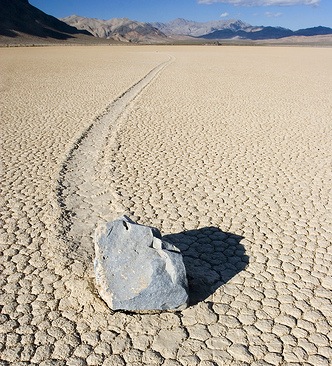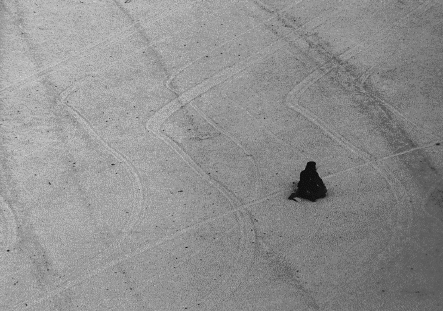Racetrack Playa Rocks!
© Charles ChandlerIn Death Valley, California, there is a dry lakebed called Racetrack Playa, which is famous for its "sliding rocks." These are chunks of dolomite that fell from the surrounding hills during the occasional rainstorms, and then somehow took trips across the lakebed while it was still muddy. Some of the tracks are over 914.4 m long, and the rocks can weigh as much as 318 kg.1Exactly how these rocks could have slid so far remains a mystery. Everybody agrees that the biggest factors are mud, wind, and cleavage. The silt/clay mixture on the playa is very slippery when wet, so friction will be slight. The valley is long and narrow, and is bounded by high mountains on both sides, which channel the wind through the valley at up to 145 km/hr. And dolomite has a crystal structure that cleaves into rhombohedral or prismatic shapes, often with slightly curved faces2 — excellent for sliding across a slippery lakebed when the force of the wind is great.Yet scientists have calculated that it would take 241 km/hr winds to move the rocks, and that's 97 km/hr faster than the record. So there has to be more to it than just mud, wind, and cleavage.One hypothesis is based on the fact that overnight, if the rain hasn't all dried up, and if it is cold enough, an ice sheet will form, with the rocks embedded in it. The ice sheet will add a lot of surface area, so the effective force of the wind will be far greater. This will give 145 km/hr winds the ability to move rocks that otherwise would have taken 241 km/hr winds.In support of this hypothesis, there are a number of examples of multiple tracks remaining perfectly parallel, even when making sharp turns. This can only be evidence that the rocks were part of a larger entity, which can only be an ice sheet.But the parallel tracks only occur in one small section of the playa, where the ice sheet gets thicker and endures longer, because it is in the shade of a huge cliff. Elsewhere, rocks that moved during the same event took paths that did not stay parallel. Furthermore, scientists have driven stakes into the playa near a couple of rocks, and during the next event, the rocks moved, even though the stakes stayed in place, and should have prevented the ice sheet from moving.It's possible that another force is present — electromagnetism. Air passing through the valley is positively-charged, since it has passed over the highest mountains in the Lower 48 to get into the valley, and since positive charge increases with altitude. The electric charge in the air induces an opposite charge in the Earth, creating an electrostatic potential between them. Dolomite, being composed of calcium, magnesium, and sometimes with traces of iron, is a good conductor. Being in contact with the wet surface, it will be negatively charged, and will therefore be attracted to the positive charge in the air above. Sticking up above the perfectly flat playa, the rocks will concentrate the lines of force on themselves, accentuating the effect. The upward electric force will then offset gravity a little bit, reducing the friction and allowing the rock to travel more easily.Confirming this hypothesis could be done in a relatively straight-forward manner. An electric field meter and a GPS unit could be affixed to one of the rocks. The hypothesis predicts that the GPS unit will record movement of the rock only when the electric field is the most powerful.A simpler test, which would prove the effects of the forces but without measuring them directly, would involve placing two artificial "rocks" on the playa, near the real ones. The two introduced objects should be identical in size, shape, and weight, but one should be an excellent conductor and the other should be a poor conductor. The hypothesis predicts that the better conductor should move further, because it will experience more net uplift due to the electric force.In short, only a combination of mud, wind, cleavage, and an electric attraction can bring the rocks in Death Valley to life.
References
1. Messina, P. (1998): The Sliding Rocks of Racetrack Playa, Death Valley National Park, California: Physical and Spatial Influences on Surface Processes. ⇧
2. Friedman, H. (1997): The mineral dolomite. ⇧












